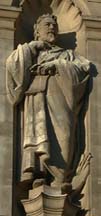It must be accepted that much of Leighton's art reflects his fundamental reserve. He was not a man who felt the need to communicate his inner feelings or his experience of life through the medium of art; nor was he an artist capable of moving an audience emotionally. By comparison with some of his more forthcoming contemporaries, most notably Edward Burne-Jones, he seems cold and unfeeling. None the less, it is the case that Leighton cared passionately about the purpose which his art served — which was that it should uplift and inspire by the function of an abstract beauty intrinsic in the harmonious arrangement of colour and line.
The formal qualities of his art were essentially more important and powerful than its capacity to inform an audience. His strength lay in his extraordinary visual sense and in his capacity to compose in a way which was both decorative and symbolically informative; he knew how to arrange colour and texture with sumptuous effect; and he represented the external world with a degree of naturalism which pleases the eye without falling into the trap of mere duplication of reality. Leighton's art, which might at first seem dry and dependent upon erudite interpretation, is in fact sensuous and even passionate. — Christopher Newall, The Art of Lord Leighton, p. 140
Biography
Thomas Brock, Frederic Leighton. c. 1892. Bronze. 32 1/2 inches.
Statue on the façade of the Victoria and Albert Museum. London, near the Brompton Avenue entrance. [Photograph by George P. Landow, December 1999.]
Born at Scarborough. Studied in Florence, 1844 and from 1849 for more than two years at Frankfurt. In Rome, 1852-55; contact with John Gibson, sculptor, and the painter/sculptor Gerome. Settled in London 1860. In 1866 settled in Holland Park Road near G. F. Watts. Chief works in sculpture include: Athlete and Python, The Sluggard and "Needless Alarms". Like Holman Hunt and Watts, Leighton made small models to assist him in the composition of certain pictures, e.g. The Daphnephoria. [British Sculpture 1850-1914, p. 27.]
Frederic Leighton had an extraordinary and far-ranging talent; as a painter this is recognisable in his works, from his large-scale Academy pictures to his highly personal oil studies and landscapes. Perhaps partly as a result of his upbringing and academic art education in various parts of Europe Leighton had a more sophisticated understanding of aesthetics than almost any of his British contemporaries. Throughout his career he was closely involved with the Royal Academy; his most important pictures were exhibited there, and were generally met with an enthusiastic response. He succeeded Sir Francis Grant as President of the Royal Academy in 1878, and despite the schism that had been caused in the sphere of painting by the inception of the Grosvenor Gallery in 1877, he himself was sufficiently august a figure to transcend the divisions and rivalries of the period. Leighton's greatest paintings are mythological subjects or scenes from ancient or Biblical history. Unlike many of his contemporaries he understood the true spirit of classicism in painting and therefore did not rely on mere archaeological reconstruction, but rather created timeless settings of simplicity and great visual strength. Nothing conflicts with, or distracts from, the physical or emotional drama which is the subject of the picture. Leighton is arguably the greatest of High Victorian painters. Only Burne-Jones has any claim to compete with him for this primacy. — Christopher Newall, A Celebration
A.R.A., 1864, R.A. 1868, P.R.A. 1878, subsequently knighted. Created Baronet 1886 and Baron (under the title Lord Leighton of Stretton), 1896.
Biographical Material
- Leighton's home and studio (many views)
- Uniquely Welcoming: Leighton House Transformed
- Melbury Road, Leighton House, and the Holland Park Artists' Houses
Works
Commentary, Critical Reception and Artistic Relations
- Comments on Frederic, Lord Leighton by M. H. Spielmann (1890)
- Drapery in Leighton’s work
- "A Victorian Master: The Drawings of Frederic, Lord Leighton" (exhibition review)
- Max Beerbohm's caricature of Leighton trying to recruit Rossetti for the RA (1922)
- Frederic Lord Leighton — Aestheticism with a Hint of Didacticism
- Desiring Women: Myth, Love and Leighton’s Clytie
- Leighton's Method of Developing a Painting
Bibliography
Newall, Christopher. The Art of Lord Leighton. London:Phaidon, 1990.
Newall, Christopher. A Celebration of British and European Painting of the 19th and 20th Centuries. London: Peter Nahum, nd [1999?].
Ormond Leonée and Richard. Lord Leighton. New Haven and London: Yale UP, 1975.
Wood, Christopher. Olympian Dreamers: Victorian Classical Painters. London: Constable, 1983. 33-80.
Last modified 3 December 2021

